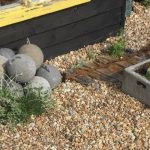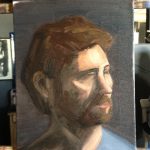Everyone loves art in one form or another, from music to writing, dance to drawing, garden design to poetry, acting and performance to comedy or processions. In the UK, we’ve been proud of our art scene, it’s a huge part of our culture. Driven by artistic talent nurtured lovingly at the heart of our communities, our arts often at the forefront of our national identity, admired across the country and on the global stage.
And yet, in recent years, deprioritising of the value of arts, funding cuts and flawed funding models have harmed the British art scene more than most people may realise. Britain is one of the worst funders of art across Europe, one report stating visual artists have seen a drop in earnings of 40% since 2020, and the situation is worse for women than men.
As an artist myself, I have recent experience that shone the problem brightly in my eyes, and I’ve spoken to other artists in different disciplines who tell me of multiple horror stories. Quotes from some of those artists I have included anonymously below.
The picture is a depressing one, given the mood of the country and changing face of our communities and high streets. Actually, when you hear from people affected, their livelihoods and passion, decimated, it’s heartbreaking. Seeing and hearing artists lives impacted so badly, and repurcussions that has on us and our economy, I have to speak up. I won’t pretend to know everything, far from it, so please treat this as the start of a conversation.
It is easy to demonstrate that investing in our arts properly will help Britain to improve economically, as well culturally, arts help understand and explore our world, healing divisions. I hope things change for the better for our British arts.
Broken models of funding
“I think I have a type of PTSD from losing out to arts funding,” one artist said to me, which at first I thought was a joke until I realised it wasn’t at all. It was a painful admission said with seriousness and sadness. The trauma of loading a funding application with hopes, dreams, passion to be turned down for reasons that didn’t make sense. Without help or regard for what happens when you lose out. For what impact it has when you keep losing out and losing out. That feeling of rejection, over and over.
That short sentence was the last straw for me, it sparked me to write this article. After years of hearing so many people talk of their damaged careers and personal impacts, both emotionally and financially. Of seeing artists on television appealing to politicians and the rest of us through the 2008 financial crash, austerity cuts that again hit arts first, pandemic lockdowns with further cuts and loss of work that still hasn’t recovered, to more cuts from the Liz Truss economic crash, the subsequent cost of living crisis… I have to raise my voice for all artists to say that while I don’t understand the whole picture, I see enough to know something is not right and we need to talk about it. What’s happening in the UK right now, what we’re doing to our artists, to people, it is not right, we are letting them down.
Another artist summarised, “It’s such a complex state of affairs, which has to be levelled predominantly at the Tory ideology, who’s systematic erosion of the arts in schools has downgraded interest, engagement, and expression at grass roots level and blocked pathways for future artists/audiences – cutting off a life line for so many unless there is economic privilege to enable them to participate (furthering division in the UK). Couple that with rampant austerity. the collapse of local authority funding and diminished central governmental funding for the Arts Council – we are now seeing a perfect storm. There are beacons of hope and perseverance but from multiple perspectives, I have conversations daily pertaining to the fact the arts are on their knees.”
My experience of applying for arts funding
I’m no stranger to funding, as a landscape garden designer focussed on a particular style of artistic expression with plants and wildlife, my work is dependent on being commissioned by people who want that. As a freelance writer, all of my writing work is also commissioned. Books in particular work like grants, or a loan you don’t have to pay back, where the publisher gives you an advance payment ahead of publication.
Recently I applied for one of the Arts Council’s ‘Develop Your Creative Practice’ grants, the first arts grant I’ve ever applied for and I want to share it to bring to life the individual impact. Due to public funding cuts, this is one of the funds now dependent largely on National Lottery funding. Artist friends encouraged me to apply as they’ve seen my interest in landscape drawing and watercolour grow, feeling I was a prime candidate, but they also warned me of the perils of the system. Mention of the admin area you have to apply to, ominously referred to as Grantium, is met with groans. Worse, the impacts of being turned down by Develop Your Creative Practice, or DYCP, I’ve seen first hand are devastating because often, people depend on them to pay the bills.
Going in, I thought I’d be OK, that I can handle an application form and if I am turned down, never mind I’ll move on. I’m a resilient person able to move on from minor disappointments, I have them all the time, a project that doesn’t happen, a job turned down. Keep going and move onto the next commission, it’s part of being an artist. To cut to the chase, I was turned down for a DYCP grant and while I have moved on from not receiving the money, the impact has been significant, to me personally and to my business, which had been ticking along nicely until I applied for a DYCP grant. I wish I had never heard of or applied for a DYCP grant.
As I explained in my DYCP application, my studio has been focussed on garden installation, writing and photography. Over the last few years I’ve been learning watercolour and I’m at a point where I want drawing and watercolour of landscapes to become a fourth new arm to my ecology led art studio. I know I’m at a point where I will only truly improve by investing much more time practicing.
The requirement of Develop Your Creative Practice is that it must be solely about developing your creative practice, it cannot be used for lessons or courses, it’s specifically about helping carve out a big amount of time to focus on you. And yet, it’s not just about you. It also has to be about community and contribution. You aren’t allowed to sell anything from what you make.
I was fine with all of that, it made sense to me. DYCP is a generous altruistic scheme that allows recipients who need time and financial backing to accelerate a new part of their creative practice. To immerse themselves in new worlds to develop new understanding and ways of conveying that, eventually benefiting the wider public from the skills or experience they have acquired.
The Arts Council actively encourage you to be ambitious, to form a project that is up to a year long. With that encouragement I formed a half year project (in reality slightly longer at seven months) that would involve a couple of days a week, every week for six months. Normally I work full time with a well balanced set up that allows me to mix design, photography and writing alongside the important process of research in gardens and outdoors in nature. It isn’t a perfect set up and it’s fragile trying to balance everything. I obviously don’t get paid for research time but it is essential to all of my work, I can’t do one without the other, so half of my year is largely unpaid research, growing plants and going out studying wildlife. Making me completely dependent on the paid bits of my work to cover the cost of everything else. Which made planning for a half year project for the Art’s Council’s Develop Your Creative Practice, if I were to receive it, a huge and disruptive risk to that careful balance I’ve worked so hard on for years. Taking out almost half of my paid work for six months, that I’m reliant on to pay for bills and fund my business, that is a big ask.
But I took it seriously as the Arts Council advises. I planned out my half year and I began blocking out time from my paid work to make way for a possible massive art project if I do receive the funding. This was my first mistake and the biggest reason I wish I had never applied for a DYCP grant, which I’ll explain shortly.
A Develop Your Creative Practice grant works in a few steps, let me explain:
- Apply for access to Grantium the admin area to check you are eligible – this takes a couple of weeks while a few basic checks are made. Yes I was eligible, great!
- Complete a DYCP application form and wait for it to be approved as eligible – I spent weeks on my application, carefully writing it, pulling together examples of my work. Asking my art tutor and a client for a supporting quote. I painstakingly plotted out my six month plan in a spreadsheet, spending hours researching hundreds of materials to break down every single cost and minute of time to the level of detail I expect for my studio. But in the end, you can’t submit any of that information, you can only enter a top line summary. I adapted everything I’d worked on and submitted what I could in the limited Grantium forms, and two weeks later I was again approved as eligible.
- Wait two months – then you have to simply wait for 2 – 3 months while all of the applications are reviewed, a panel of unknown people read them all and then make the decision months after you have applied, and you don’t know if you will or won’t receive the grant until that very day. You’re not given any indication whatsoever beforehand, so you hope, while telling yourself you probably won’t get it.
- Receive the outcome – eventually, the decision day comes around at which point you receive a message in Grantium telling you if you receive the grant or not. If you do receive the grant, you have to start what is likely a massive art project immediately, and if you don’t receive it, well, you’re probably fucked.
This is one of the fundamental problems with art funding in Britain right now, demonstrated by Develop Your Creative Practice. It is a lottery that requires you to clear a huge chunk of your time and potentially income to make way for a dream that you probably won’t get. You have a one in four or so chance on average of receiving the Develop Your Creative Practice grant.
Having gone through the process myself, I can see how demoralising and problematic the Develop Your Creative Practice grant is. It’s trying to be something for everyone, is oversubscribed because of limited funds elsewhere and it has no consideration for what happens to unsuccessful people afterwards. It actively encourages people to submit bold applications but then also encourages you not to submit an in-depth or proper plan, and encourages you to not take it seriously, because how can you plan for a 6 – 12 month project if there’s a risk you won’t get it?
I realise now I was stupid to plan in so much detail. Who has the time to do all of that, to write a detailed plan, set aside 6 – 12 months of potential lost time, with an additional 2 – 3 month waiting gap beforehand, only to risk not receiving it? When that time could have been used for something more productive. The scheme almost actively encourages people to assume they won’t get it, and then deal with the consequences afterwards if they do.
One answer could be that the grant is for people who don’t have an existing income stream, that the DYCP grant is truly only for people who need the money to survive. My creative practice is hardly hugely financially successful, but it works and was ticking over nicely, so I was aware that possibly I shouldn’t be applying at all. But DYCP says it isn’t just about people on low incomes, it actively encourages people to apply who need to finance time off their existing work to develop their creative practice. I am not in a financial position to fund a whole day of development for 6 months, I could only do that with something like a grant, so I applied. On flip side, I guess you could also argue that DYCP is for wealthier artists who can suddenly drop an existing income stream if they’re successful.
The reason I was given for not receiving a Develop Your Creative Practice grant are also contributed to me wanting to say something. I was actually ready not to receive the grant, I knew I’d be disappointed, but I can move on from disappointments easily – glad someone else who might need the funding more than me did receive it. But I was told the following, and the second point is fundamentally wrong on multiple levels:
Your application was not successful mainly because:
Other applications were preferred.
Panel noted that – your application didn’t clearly show us how your activity meets the aims of Developing your Creative Practice.
Point (1) Other applications were preferred, I completely understand. In a grant fund oversubscribed, other applications will be preferred, it’s the nature of the beast.
Point (2) Panel noted that – your application didn’t clearly show us how your activity meets the aims of Developing your Creative Practice. This however did not sit right with me, and is another reason why I am writing this.
I emailed the Arts Council asking them to explain what they mean so I can learn from the process in case I apply again, and I promptly received a reply telling me the Arts Council does not give further feedback. Basically, they expect us to guess.
This is the second fundamental problem with Develop Your Creative Practice, the requirements appear deliberately obtuse and from the response I received, I don’t think they are even clear to the panel. It is trying to be something for everyone, but in doing so, is potentially harming more people than it helps.
That second piece of feedback frustrates me because we have a situation where artists are telling a panel what needs to happen to develop their creative practice, only for someone who doesn’t know or understand their studio, to tell them they’re wrong. That is not right, I dread to think how many artists take such feedback and then don’t go on to develop their practice in the way they have carefully spent time planning.
In the spirit of being constructive, I’m no expert on this fund but some suggestions to improve it would be:
- Stop trying to be something for everyone – if it’s means tested, make that clear upfront.
- Or, stop pretending it isn’t a lottery – if it is something for everyone, the decision should not be entirely up to a panel, bung all of the applications that meet the criteria into a bucket and pick at random.
- Include an extra step early on that challenges the application (e.g. we don’t understand how this develops your practice) giving artists a chance to explain properly and give feedback on that if unsuccessful.
- Replace Grantium with an admin area fit for 2025.
Artists are not businesses
There are further sources of funding out there, locally and nationally but with the arts overall being hit financially from all directions, the sense I get from artists is that they’re being encouraged to fend for themselves. There seems to be an expectation that artists should put business principles first, their art second.
If you’re new to the art world and funding, you may be wondering what’s wrong with that? Why are artists are so dependent on funding in the first place. It’s because in the past, art was recognised for its important role in society, it’s why our galleries are publicly funded to keep them free and accessible to everyone. The same principle was applied for generations for creating new art, recognising it’s hard to produce art while you worry about paying bills. Public funds are used locally and nationally to create art for communities to enjoy, that become a part of who we are. Funding art keeps it free or low cost, making it accessible to all.
“From an independent artist perspective, you just feel totally abandoned by the Arts Council. A sort of wall has come down, you can no longer access them for any support.” One artist explained, whose career has been encouraged to be partly dependent on funding that has suddenly stopped, “By making DYCP one of the only sources of funding independent artists can access, it’s making it highly competitive and it’s just impossible to access funds. But also they’ve abandoned us as well, there’s been no dialogue or discussion that funding will shrink to such a degree, on how are artists are going to make a living?”
This artist is one of a number I’ve spoken to who was led into a long and successful career partially reliant on funding, which has simply been taken away by previous Governments. Alongside the various causes of the cost-of-living crisis means their world has changed dramatically. And the message being given is that they need to find their own money in more commercial ways, but artists aren’t trained to be a business; they go onto explain, “there’s no support for transitioning into a different way of working, no discussion or support for a hybrid model that might be coming up. As a result, people feel very isolated, very alone.”
“There’s also a political thing that’s going on, I don’t know how you’d articulate this, where there’s an anti-artist, anti-creativity and how interesting it’s been that organisations can’t shake that off. This fear about being creative, being an artist, how undervalued it is in our society. Spurred on by right wing politics and right wing media, this hatred of art and hatred of creativity, and how dangerous that is, and how Brexit, pandemic, cost of living crisis amplify this fear of artistic talent, but how shortsighted that is. All of that, alongside feelings of wasting your time, they’re happy for an application to just waste people’s time.”
What can artists do themselves?
Ultimately, I believe British public and politicians can help by looking critically at our incredible art world to understand the financial pressures our artists are facing. Art benefits us all personally and financially in many ways, it’s worth protecting.
In the meantime, my experience of funding has made me decide to do what I can to help independent artists by sharing what I’ve learnt. I’ve begun knowledge sharing my expertise around online technology and pricing models with artists.
My art practice isn’t financially perfect, as my funding application proved, it’s a fairly fragile balance. But I have learnt to be somewhat independent and to ride the balance of making a living while also carving out some of my time to focus on the art I want to create. How I will find time to develop my landscape art to the level I want quickly, I’m not sure now, but I will find a way without relying on people who know nothing about me making decisions about my life.
Some tips I would offer to independent artists right now are:
- Find a manageable income stream that lets you still practice some of your work – it might not be perfect, often doing art for money erodes what we want to really create as you have to tailor it to something people want to buy, but in this current world, I recommend we all do it. Examples of this could be:
- Produce some work people can buy regularly – this could be producing some art to sell that you wouldn’t necessarily want to do if you had funding, but is acceptable enough to you to work on. For instance, regular performances people will pay to see, smaller pictures people can buy, prints of your work etc.
- A newsletter or site with a paid subscription element – look at Substack or Patreon.
- Set up an online shop to sell your work – Shopify is easy to use.
- Build a social media audience who like your work – choose one or two platforms that fit your work, Instagram is good but its algorithm is making it harder to get noticed. But Instagram, Tik Tok and YouTube are the most visual platforms. Personally I am investing my time now in BlueSky, which is like Twitter from ten years ago, but also has some protections for users (e.g. you can move your account to other platforms in future).
- Offer training in person or online – artists have valuable skills worth a lot of money shared, a few days of training other people can be a good income stream.
As an example with my studio, I accept commissions for garden designs and commissions for written articles, I also plan to sell some of my landscape paintings, or prints of them, as soon as I am happy with them. In an ideal world, I would have unlimited money to do whatever I wanted in all of these fields, but I have to work to pay my bills, so to remain independent, I make the most of these and around that fit in the work I specifically want to produce myself.




This is an excellent analysis of a depressing situation. Thanks for taking the time to post it.
Thanks Chas, I wanted it to be constructive but also explain the problems that are affecting people’s lives. I always feel optimistic that things will get better, but it does seem to be taking a long time. In the meantime I’m here to help artists find platforms to make money.